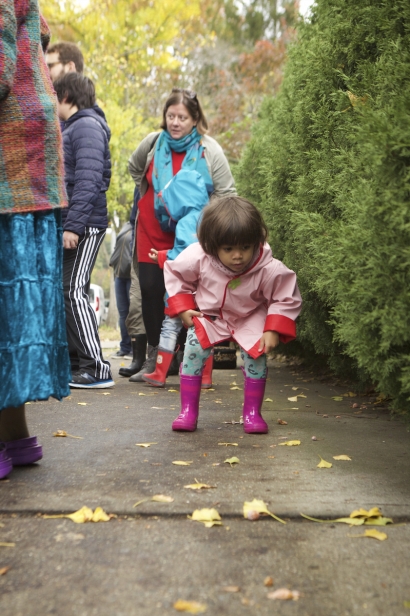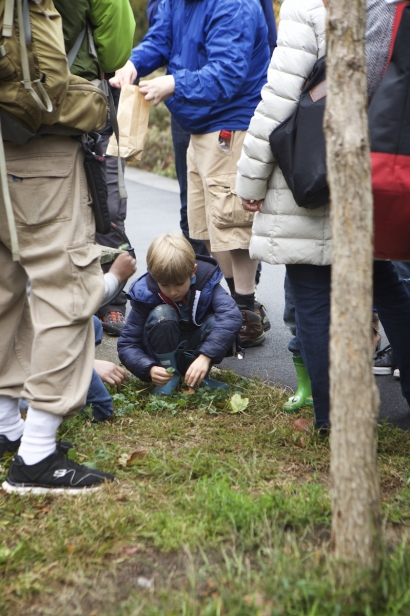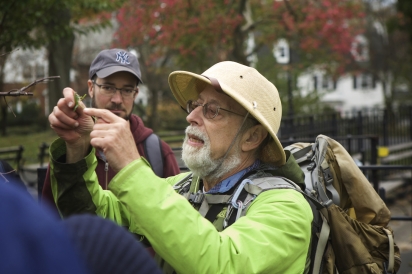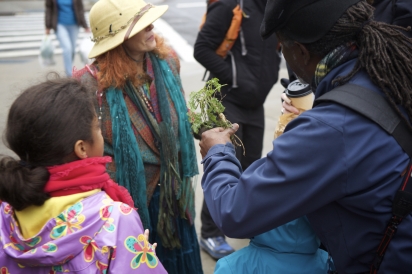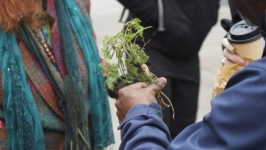Mushrooms, Mallows, and Burdock, Oh My! “Wildman” Steve Brill teaches foraging in Forest Park
A few years back, growing increasingly concerned about climate change, generally, and the impact of our individual choices, specifically, my husband and I decided to be more thoughtful about how we were consuming—food, especially. We loved blueberries in winter, but the carbon footprint of the indulgence seemed selfish.
We expanded efforts we’d begun a few years earlier, joining fellow food writer and Astoria resident Zora O’Neill and her husband in an annual CSA share. The next year, we went in on a CFA—a fish share—with weekly deliveries of locally caught fish, and then we went whole hog—literally—buying an entire pig each winter and divvying it up among a few families. Zora would even render lard and distribute jars to those of us who wanted it.
But there was at least one other step to take in our quest to eat as much locally grown and produced fare as possible: foraging. I ordered two classics by Euell Gibbons, a 1960s writer whose Stalking the Good Life and Stalking the Wild Asparagus read like a cross between naturalist Ed Abbey and a Peterson field guide. I scanned websites and forums to acquaint myself with foraging ethics and to answer some burning questions about urban foraging, namely: What about dog pee? According to Brill, there are so many pesticides found already in the greens available in markets that, well, what of it? The practical answer is to not forage right off the urban sidewalk—to literally go off the beaten path and deep into the city’s parks.
I made tentative first efforts, beginning with a bountiful haul of ginkgo nuts, collected at Dutch Kills Playground while my kids careened between the swings and slides. Proud that my initial excursion reaped such a yield, I stuffed a shopping bag full of the nuts, not realizing I needed to squeeze off the fruit surrounding them to avoid an apartment that would stink for days. Suddenly, my husband was much less excited about foraging.
“Yep, the ginkgo smells like decaying flesh,” says “Wildman” Steve Brill, arguably New York City’s most famous forager. “And wet dogs, too,” adds his friend, Stacy, an enthusiastic forager herself. Brill meets us, along with about 20 other amateur foragers, on the corner of Park Lane and the Union Turnpike for a Sunday morning tromp through Forest Park. Before we even begin, one eager participant, equipped with his own spade, kneels at the foot of the stairs that lead to the park’s administration building to dig up what he thinks is a wild carrot.
He’s right—it is. “Wildman” Steve holds the first find aloft, pointing out its soft green top. He scratches the root and asks everyone to sniff, pointing out that a similar looking plant, which is poisonous, lacks the tell-tale carrot smell. The participant’s mother, proud of her son’s discovery, snatches the carrot and stashes it. “We want to take it home with us,” she says with a smile, but one that clearly conveys she views us as competition.
This isn’t a trip organized specifically for families, but today, at least, it has attracted them. Ours is the only Queens family; the rest are tourists who have read about “Wildman” Steve or locals from other boroughs and one father-son duo from Long Island. They’ve gone on excursions with Steve before and are clearly Scout badge–level foragers, who can already identify most plants and have arrived with their own Ziploc bags.
I’m not doing so badly with identification, either. Having grown up in a rural area with scientist parents who believed it was important to know the names of the flora and fauna surrounding us, and having nurtured my love for the outdoors with a college botany class and an absurd number of field guides for a city dweller, I’m able to identify Queen Anne’s Lace, ginkgo, sassafras and more. My 8-year-old is impressed. Her mother, the same one who embarrasses her by merely breathing in public, has this cool storehouse of knowledge she hadn’t even known about.
As this tour confirms, perhaps my field guide collection isn’t absurd at all: There’s gold in them there hills, green gold. There’s mallow, burdock, bitter dock, black walnuts, spice bush and several kinds of mushrooms. You can make a vegan beef jerky with the burdock, Steve says, offering samples. He also passes around a sweet and savory bitter dock snack: The leaf has been coated with a blend of sesame oil, miso, stevia, dates and melted chocolate, a thin, crispy, melt-in-your-mouth treat. The spice bush and sassafras can both be turned into teas. New York City’s parks, it turns out, are a forager’s paradise. You just have to be willing to slow down and pay close attention to everything around you.
In the most basic way, my husband and I knew this already. And though our youngest, ages 3 and 4, are more interested in finding sticks and digging holes, we can see that our 8-year-old is coming alive with this knowledge. A cloth bag draped over her arm has been stuffed with treasures. While most aren’t edible—she’s gone for beauty over function—some are, and she can recite the names of each item in her bag, a wondrous newfound knowledge she’s planning to drop on her classmates. “What did you do this weekend?” I hear her ask her friends as I drop her off at school the next morning. “I went foraging with ‘Wildman’ Steve in Forest Park….”
“Wildman” Steve Brill leads guided tours of city parks in Queens, Brooklyn and Manhattan, as well as some surrounding counties, Long Island, New Jersey and Connecticut.
“Wildman” Steve Brill | @wildmansteve
Zora O’Neill | @zoraoneill
Euell Gibbons
Stalking the Good Life and Stalking the Wild Asparagus
Ed Abbey
Peterson Field Guide
Forest Park



